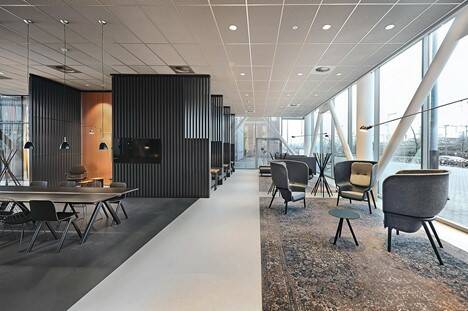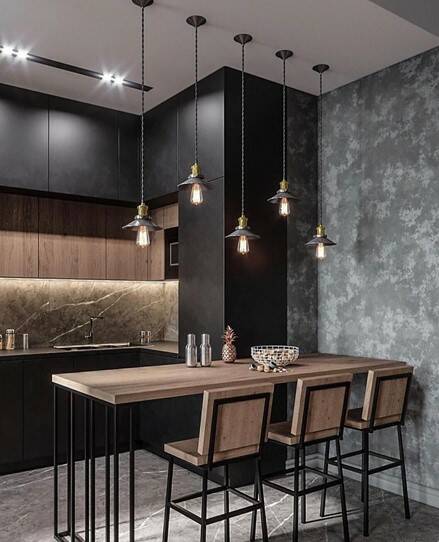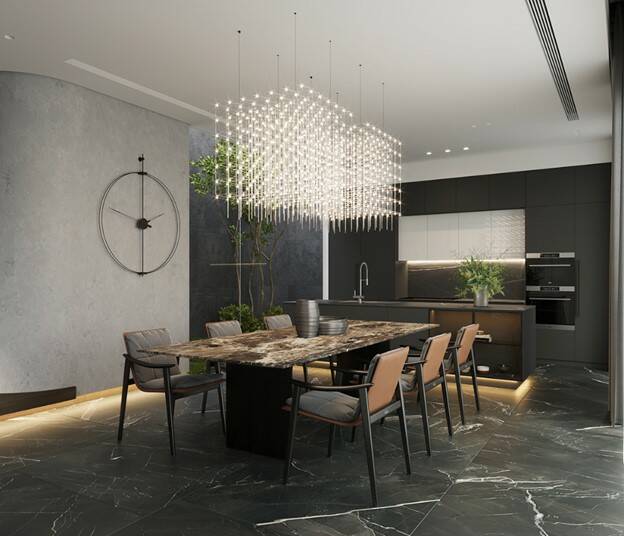- Home
- / Blog
- / Interior Design
Task Lighting for Interior Design
02/28/2022
Task lighting in interior design refers to a type of light fixture that provides a focused beam of light directly onto a work surface. Unlike ambient lighting, task lighting does not brighten the rest of the room. It is more functional than decorative, and is used for activities that require closer inspection.

Why you need to Incorporate Task Lighting in Interior Design
Wondering whether to include task lighting into your interior décor? The following are remarkable ways in which task lighting can improve your interiors.
1. Functionality and Productivity

Attaining functional task lighting in your home can enhance your daily living significantly. It provides the right kind of light for any activity you'd like to perform, reducing eye strain often associated with working under artificial lighting. Adding task lighting to interior design can therefore increase productivity and the effectiveness of the room.
2. Energy Efficiency
Task lighting has been around since the invention of electric light, but it became more popular in recent years as part of a new emphasis on green design. Task light helps to reduce the energy required to illuminate a room, while still providing enough light to make tasks easy and accurate.
3. Contribute to Ambient Lighting
When installed overhead or attached to walls, task lighting contributes to the general ambient light or accent light. One of the basic principles of interior lighting is layered lighting. This involves the incorporation of three layers of light, namely, ambient lighting, accent lighting, and task lighting. An expert lighting designer incorporates all these three layers in their interior design. However, these lighting layers are not always distinct, with task lighting sometimes contributing to ambient lighting, or doubling as accent lighting depending on the use and positioning. It will generally add to the illumination levels of the space.
4. Visual Comfort
Task lights are especially important when the room is large and has high ceilings. A light fixture above a table can be a part of general lighting, but it will be more effective if it can direct its beam of light toward the workspace rather than shine indiscriminately on the ceiling and walls. Clear, unshaded bulbs will give off a harsher glare than frosted or diffused bulbs. Try to keep lights that do not need to shine directly on your work level and out of direct sight.
5. Defining Functional Spaces

Lessons about Office Design, De Vorm | Interior Products, via Pinterest.
Creating well-illuminated living spaces is important, but so is creating spaces with defined purposeful areas. Task lighting creates defined spatial zones, especially in open-plan spaces. The nature and intensity of task lighting in every location will be determined by the intended purpose of that area. Therefore, the task lighting provided will create a clear demarcation of the different working zones in the room. For instance, in an open office layout, task lighting can help you tell apart the private work zones from the collaborative workspaces and conference areas.
Considerations when Buying Task Lighting
Many factors are crucial in selecting the best task lights for your indoor lighting design. The following are just a few of the top elements to consider.
1. Purpose of the Lighting
The first thing that you must consider when choosing task lighting is the purpose of the light fixture. For instance, if you want a light fixture to focus on a flat surface such as a desk, then you need to choose the right size and shape of the light fixture. On the other hand, if you want a light fixture for general lighting in an entire working zone, then you need to consider its energy consumption and efficiency rating.
2. Lamp Specifications
The purpose of the task lighting will determine the lamp type you go for and the various specifications required for it to supply adequate quality lighting for the task at hand. Whether working with a fluorescent, incandescent, halogen, or LED bulb, a high Color Rendering Index is recommended for task lighting.
The Illuminating Engineers Society recommends different standards of light outputs for different tasks. Hence, selecting the right lumens for your lighting is prudent. For instance, a light source of between 200 to 500 lux is adequate for reading printed documents or newspapers. However, a lighting level of between 2000 and 5000 lux is required for intricate small-size visual tasks.
3. Age of the User
According to research, age affects the eye’s ability to receive light. When providing task lighting for an older person in their 60s, you will need to provide at least 250% more lighting levels than a 20-year old, whose visual performance is taken to be eight times greater. However, older people are more prone to visual fatigue, discomfort, and eye strains. Thus, providing diffused quality lighting and avoiding glare is key.
Read Untold Facts About Light in Architecture to learn how you can improve light quality and visual comfort in your architectural lighting and interior design.
How to Best Position your Task Lighting in your Interior Design
How can you place your task lights for maximum effect? Task lighting is often placed at 90 degrees to the normal line of sight, which means that it directly illuminates the object of focus. The use of a dimmer switch with a lightbulb will enable the user to switch from one task light to another where they need it most.
When lighting for intricate and small-size activities, task lighting should be adjustable and illuminate an area no larger than 40 square feet. Positioned as a downlight above the illuminated surface, the lamp is ideally placed 14 to 24 inches above the work surface. Placing a light source in close proximity maximizes the light output onto the illuminated work surface.
When using task light to illuminate flat surfaces for reading for an extensive period, it is advisable not to position the fixture directly above the work surface, but slightly on either side to avoid reflection and glare. When it comes to desk lamps with adjustable heads, position the light at a 30-degree angle to avoid glare. Going for a diffused light source will further help in softening shadows and minimizing glare. Additionally, avoid aiming the light source directly into your line of sight to ensure visual comfort.
How to Incorporate Task Lighting into your Interior Design
Task lighting is designed to illuminate work areas. The light produced by a task lighting fixture is generally directed at work surfaces rather than fixtures or people. Found under furniture, in cabinets, shelves, or on countertops, a task lighting fixture is typically used within the functional area where work is done.
Task lighting is ideal for work areas in a home, office, or school. The purpose of task lighting is not to illuminate the entire room, but rather to provide enough light to help the user see their work area clearly. Below are some types of task lighting and how to integrate them into your interior lighting design for more productive workspaces.
· Office Areas
Most offices include general task lighting in the overall design, but this lighting doesn't always reach every workstation. Whether a commercial office space or your home office, task lighting should provide you with proper lighting to perform specialized tasks at your workstation.

Overhead task lights are typically mounted directly over work surfaces, such as desks or tables, to illuminate the work surface. In commercial and office spaces, recessed lighting fixtures with built-in lenses, filters, and reflectors also serve to specifically direct clear light downward on the workspace below. Recessed lights come in a range of specifications and light outputs that make them a great fit for task lighting.
Retrofit lamps are most often used in recessed installations in the ceiling, with the light source positioned inside a reflector. They are generally found in ceiling-mounted equipment niches, called drop-in ceilings, in schools, office buildings, and industrial work areas. For meeting rooms and conference spaces, placing pendant lights over the conference table will provide lighting to the immediate work surface.
· Bedroom Areas

For your sleeping areas, bedroom reading lights and bedside table lamps are amazing ways to make your side of the bed more functional without affecting the partner sleeping right next to you. Bedside lamps are vital for bedrooms. If you like to read before bed, make sure your bedroom has enough light for this. The general light level of the room may be dimmer, but the task light creates an intimate space that is pleasant to read in. You can then complement it with warm accent lighting and ambient lighting to set the mood of the space.
· Bathroom areas

Place a mirror light, a shaver light, recessed light, vanity light, or a picture light above your bathroom mirror to turn it into functional areas for tidying up and getting ready. Wall sconces or pendant lights on each side of the bathroom mirror also make the perfect task lighting.
· Kitchen Areas

Indusztriális lakberendezés, Ledpont, via Pinterest.
Kitchen pendant lighting has a great impact on the kitchen islands, providing adequate lighting for cooking. Additionally, under-cabinet lighting is also an excellent way to highlight your kitchen cabinets and provide your kitchen with enough light for food preparation tasks.
· Living Rooms
Living rooms are cozy spaces meant for relaxing and unwinding. Therefore, when incorporating task lighting into living spaces, light adjustment is an essential specification that will allow you to regulate the lighting levels according to the task. Free-standing floor lamps are suitable additions to your living room décor for reading purposes.

When designing for art-centric living spaces, task lighting can also serve as art lighting for exhibiting the artworks in the room. Install track lights and picture lighting to illuminate your paintings, archives, gallery walls, and sculptures.
Read: Top 10 Lighting Ideas for your Bedroom Wall Art to learn how to best illuminate your artworks.
· Dining Rooms

Since the dining table is the most functional area in the living room, a pendant light or chandelier positioned centrally, 30 to 35 inches above the dining table, will provide just enough task lighting for serving and meal times.
· Workshops and Industrial Areas
Task lighting is used for different types of tasks and projects, from intricate projects to bigger workshop assembly projects. The type of fixture you choose depends on where you want to use it and what you need it to do. For more detailed work, magnifying task lights have integrated magnifiers that allow better viewing of small objects, providing illumination to not more than just its immediate surrounding. Invest in a light fixture with a high CRI value of 90 and above for elaborate tasks and projects.
· Circulation Spaces

Staircases and corridors make good use of task lighting to ensure safety when walking around. Add motion-sensitive staircase and corridor lighting to the staircase risers, under the treads, or below the handrails for enhanced safety at night.
Tasks Brightened, Work Lightened
No interior design is complete without task lighting. It provides functionality and improves productivity in every space, allowing you to perform various tasks with no strain. Perfect Picture Lights provides a wide range of quality task lights, picture lighting, under-cabinet lighting, track light fixtures, and art lighting to get you started with your productive interior lighting design.
______________________________________________________________________________________________________________________
 Winny Okoth is a practicing Construction Project Manager and Interior Designer. She is currently pursuing her Master’s Degree in Construction Project Management. Winny Okoth has a great passion for every form of design and specializes in 3D visualizations for architectural and interior design.
Winny Okoth is a practicing Construction Project Manager and Interior Designer. She is currently pursuing her Master’s Degree in Construction Project Management. Winny Okoth has a great passion for every form of design and specializes in 3D visualizations for architectural and interior design.


